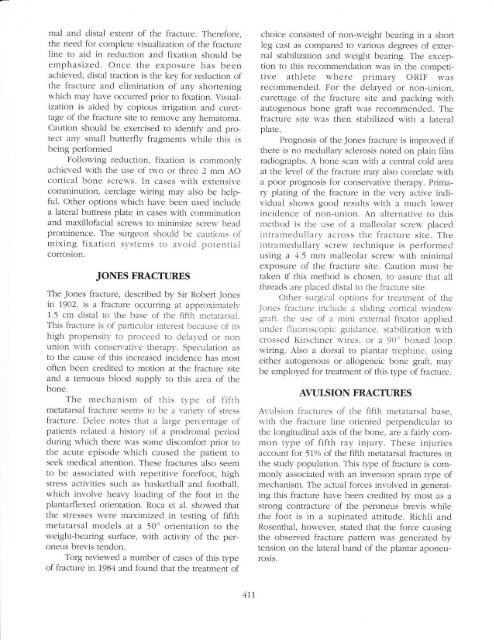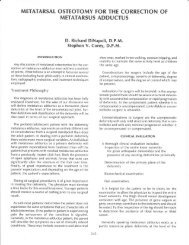Fifth Metatarsal Fractures - The Podiatry Institute
Fifth Metatarsal Fractures - The Podiatry Institute
Fifth Metatarsal Fractures - The Podiatry Institute
- No tags were found...
You also want an ePaper? Increase the reach of your titles
YUMPU automatically turns print PDFs into web optimized ePapers that Google loves.
ma] and distal extent of the fra.cture. <strong>The</strong>refore,<br />
the need for complete visualization of the fracture<br />
line to aid in reduction and fixation should be<br />
emphasized. Once the exposure has been<br />
achieved, distal traction is the key for reduction of<br />
the fracture and elimination of any shortening<br />
which may have occurred prior to fixation. Visualization<br />
is aided by copious irrigation and curettage<br />
of the fracture site to remove any hematoma.<br />
Caution should be exercised to identify and protect<br />
any small butterfly fragments while this is<br />
being performed<br />
Following reduction, fixation is commonly<br />
achieved with the use of two or three 2 mm AO<br />
cortical bone screws. In cases with extensive<br />
comminution, cerclage wiring may also be helpfu1.<br />
Other options which have been used include<br />
a laleral buttress plate in cases with comminution<br />
and maxillofacial screws to minimize screw head<br />
prominence. <strong>The</strong> surgeon should be cautious of<br />
mixing fixation systems to avoid potential<br />
corrosion.<br />
JONES FRACTURES<br />
<strong>The</strong> Jones fracture, described by Sir Robert -|ones<br />
in 1902, is a fracture occurring at approximatelv<br />
1.5 cm distal to the base of the fifth rnetatarsal.<br />
This fracture is of particular interest because of its<br />
high propensity to proceed to delayed or non<br />
union with conseruative therapy. Speculation as<br />
to the cause of this increased incidence has most<br />
often been credited to motion at the fracture site<br />
and a tenuous blood supply to this area of the<br />
bone.<br />
<strong>The</strong> mechanism of this rype of fifth<br />
metatarsal fracture seems to be a rrariety of stress<br />
fracture. Delee notes that a large percentage of<br />
patients related a history of a prodromal period<br />
during which there was some discomfort prior to<br />
the acute episode which caused the patient to<br />
seek medical attention. <strong>The</strong>se fractures also seem<br />
to be associated with repetitive forefoot, high<br />
stress activities such as basketball and football,<br />
which involve hear,y loading of the foot in the<br />
plantarflexed orientation. Roca et al. showed that<br />
the stresses were maximized in testing of fifth<br />
metatarsal models at a 50" orientation to the<br />
weight-bearing surface, with activity of the peroneus<br />
hrevis tendon.<br />
Torg reviewed a number of cases of this type<br />
of fracture in 1984 and found that the treatment of<br />
choice consistecl of non-weight bearing in a short<br />
leg cast as compared to various degrees of external<br />
stabilization and weight bearing. <strong>The</strong> exception<br />
to this recommendation was in the competitive<br />
athlete where primary ORIF was<br />
recommended. For the delayed or non-union,<br />
curettage of the fracture site and packing with<br />
autogenous bone graft was recommended. <strong>The</strong><br />
fracture site was then stabilized with a Tateral<br />
p1ate.<br />
Prognosis of the Jones fracture is improved if<br />
there is no medullary sclerosis noted on plain film<br />
racliographs. A bone scan with a central cold area<br />
at the level of the fracture may also correlate with<br />
a poor prognosis for conselative therapy. Primary<br />
plating of the fracture in rhe very active incliviclual<br />
shows good resuits with a much lower<br />
incidence of non-union. An alternative to this<br />
method is the use of a malleolar screw placecl<br />
intramedullary across the fracture site. <strong>The</strong><br />
intramedullary screw technique is performecl<br />
using a 4.5 mm malleolar screw with minimal<br />
exposure of the fracture site. Calltion must be<br />
taken if this method is chosen. to assure that all<br />
threads are placed distal to the fractr-rre site.<br />
Other surgical options for treatment of the<br />
Jones fracture include a sliding cortical u,inclow<br />
graft. the use of a mini erternal fixator applied<br />
under fluoroscopic guidance. stabilization N,,ith<br />
crossed Kirschner $.ires, or a 90" boxed loop<br />
wiring. Also a dorsal to plantar trephine, using<br />
either autogenous or allogeneic bone graft, may<br />
be employed for treatment of this type of fracture.<br />
AVULSION FRACTURES<br />
Al,ulsion fractures of the fifth metatarsal base,<br />
u.ith the fracture line oriented perpendicular to<br />
the longitudinal axis of the bone, are a fairly common<br />
type of fifth ray injury. <strong>The</strong>se injuries<br />
account for 57o/o of the fifth metatarsal fractures in<br />
the study population. This type of fracture is commonly<br />
associated with an inversion sprain type of<br />
mechanism. <strong>The</strong> actual forces involved in generating<br />
this fracture have been credited by most as a<br />
strong contracture of the peroneus brevis while<br />
the foot is in a supinatecl attitude. Richli and<br />
Rosenthal, however, stated that the force causing<br />
the observed fracture pattern was generated by<br />
tension on the lateral band of the plantar aponeurosis.<br />
477

















